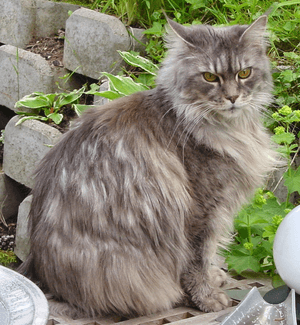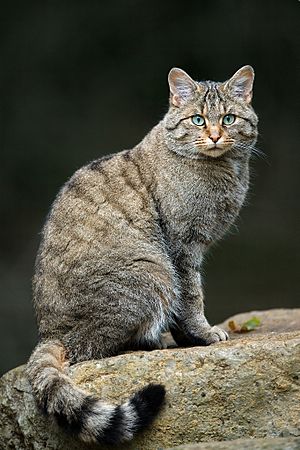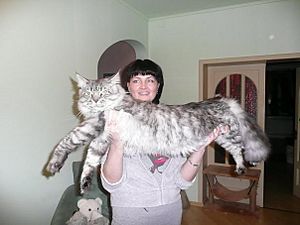British big cats facts for kids
In British folklore, British big cats are mysterious large cats that people report seeing in the British countryside. They are also called "ABCs" (which stands for Alien or Anomalous Big Cats), "phantom cats," or "mystery cats." People often describe them as "panthers," "pumas," or "black cats."
Some people believe these animals might be descendants of big cats that lived in Britain during the Ice Age, like leopards or lynxes. However, most experts don't think there's a wild population of big cats in Britain, especially a group that breeds. This is because there isn't enough strong proof.
Sometimes, individual big cats have been found, like a Eurasian lynx or even a puma captured alive in Scotland in 1980. Experts usually believe these were pets that either escaped or were set free illegally. This might have happened if the animals became too hard to manage. Also, sometimes a regular domestic cat seen far away can look like a bigger animal.
Some people think that when the Dangerous Wild Animals Act 1976 was introduced, which made it harder to own certain wild animals, some owners might have released their illegal pets into the wild.
Contents
Reported Sightings of Mystery Cats
People have been reporting sightings of these mystery big cats for a long time.
Where Are They Seen Most?
A group called Big Cats in Britain collects reports of these sightings every year. Here are the top ten areas in Great Britain where big cats were reported between April 2004 and July 2005:
| Area | Devon | Yorks | Scotland | Wales | Gloucs | Sussex | Cornwall | Kent | Somerset | Leics |
|---|---|---|---|---|---|---|---|---|---|---|
| Number of Sightings | 132 | 127 | 125 | 123 | 104 | 103 | 99 | 92 | 91 | 89 |
Early Reports
Back in the 1760s, a writer named William Cobbett remembered seeing a cat "as big as a middle-sized Spaniel dog" in Surrey. Later, he saw a "lucifee" (a North American lynx) and thought it looked just like the cat he saw before.
There's also an old Welsh poem from the Middle Ages that talks about a "Palug's cat," a giant cat that roamed Anglesey until it was defeated.
More Recent Sightings
Interest in these mystery cats grew in the late 1950s. Stories like the "Surrey Puma" and the "Fen Tiger" started appearing in the news.
In the 1970s, reports spread across the country. Famous ones include the "Beast of Exmoor" in Devon and Somerset, and the "Sheppey Panther" on the Isle of Sheppey. In 1980, the first modern report came from Scotland, and the famous "Kellas cat" was shot there in 1984.
Later, the "Beast of Bodmin" in 1992 and the "Galloway Puma" in Dumfries and Galloway became big news. In Aberdeenshire, a black panther is known as the "Beast of Buchan" and is often reported.
In 2011, many people in Shotts, North Lanarkshire, reported seeing a "panther." These reports stopped after a few months.
One of the most talked-about recent reports was the "Essex Lion" in 2012. People saw a lion and heard roaring near a caravan park in Essex. Police searched the area, but found nothing. It turned out a witness's photo was actually of her large pet Maine Coon cat, Teddy.
In 2013, two sisters near the Shropshire-Wrexham border saw a large, black, cat-like creature. They found large paw prints that were too big for a domestic cat. An expert thought it might be a descendant of a "Shropshire jungle cat" from the 1980s, or a very large domestic cat.
In 2019, a big cat was reportedly seen in Harrowbarrow, Cornwall, after it attacked a dog. Residents said local pet cats had disappeared, and a large paw print, possibly from a panther or puma, was found.
Other rare sightings include the leopard cat and the clouded leopard. There have even been extraordinary reports of lions in Devon and Somerset.

In August 2012, several people reported seeing a lion near St Osyth in Essex. Police searched with helicopters and infrared cameras, telling people to stay indoors. However, all lions at nearby zoos and circuses were accounted for, and no lion was found. A local resident later said a photo of the animal was actually her large pet Maine Coon cat.
For several years, people in Sussex have reported a cat known as the "Beast of Bevendean."
Evidence of Big Cats
People have tried to find proof of these big cats through captures, photos, and DNA.
Captured Animals and Remains
A Canada lynx shot in Devon in 1903 is now in the Bristol City Museum and Art Gallery. Its teeth showed it had spent a lot of time as a pet.
In 1980, a puma was caught in Inverness-shire, Scotland. This happened after years of sightings. The puma, named "Felicity," was put in a zoo. When she died, she was stuffed and placed in Inverness Museum.
In 1989, a jungle cat was found dead by the road in Shropshire after being hit by a car.
In 1991, a Eurasian lynx was shot near Norwich, Norfolk. It had killed about 15 sheep. This story was only reported in 2003, but a police report in 2006 confirmed it was true. It was probably an escaped animal from a nearby breeding facility.
In 1996, police in Fintona, Northern Ireland, shot a cat. It was thought to be a caracal, a wildcat from Africa and Asia.
In 2001, a young female Eurasian lynx was caught alive in Cricklewood, north London, after a chase. She was named "Lara" and taken to London Zoo, then later to a zoo in France to breed. She was only 18 months old but much bigger than a domestic cat.
In 2017, a truck driver said he saw three workers lifting a dead 4-foot black panther into a truck. However, Highways England said it was just a dead black dog.
Videos and Photos

Around 1993, many reports came from Bodmin Moor about a large black cat, nicknamed the "Beast of Bodmin." Some videos were made, but scientists said the animals in the videos were just black domestic cats.
In 1994, a video of a large black cat was recorded in Cambridgeshire and called the "Fen Tiger."
In 2006, a large black cat was filmed in Banff, Aberdeenshire. The footage was shown on the BBC.
In 2009, a police officer took photos and video of a large black cat on a railway line in Helensburgh, Argyll.
In 2010, video footage of a large black cat was recorded in Stroud, Gloucestershire. Experts thought it was at least 5 feet long from nose to tail.
In 2011, a family in Fochabers Wood, Moray, photographed a large black cat that looked like a forest jaguar.
In 2017, there were five sightings of big cats in Gloucestershire, some with photos. Also in 2017, a mother and daughter took photos of a large black cat in the Quantock Hills, Somerset, which experts thought might be a panther or jaguar.
A 2017 documentary showed footage from a police officer in the West Midlands of a large black cat. A big cat expert from South Africa said it looked like a black leopard. He also said footage from Maiden Newton, Dorset, was the "most conclusive evidence so far that a black leopard is on the loose in the UK."
During the 2020 Covid lockdowns, many sightings were reported across the country, including in Cambridgeshire, Gloucestershire, North Wales, Somerset, and Leicestershire. A cat looking like a serval was photographed in North London.
In 2021, a large dark cat was filmed in Flintshire.
Attacks on People
In 2000, an 11-year-old boy in Monmouthshire said a large black cat attacked him, leaving five claw marks on his cheek.
In 2005, a man in south-east London was attacked in his garden by a large black figure. He said it was much stronger than him and left him with scratches. Police said one officer saw a cat the size of a Labrador dog.
In 2019, a man in Cornwall reported that a 6-foot black cat attacked him through an open window. He described it as a mix between a domestic cat and a panther.
DNA Evidence
There have been mixed results from DNA tests: In 2011, hairs found in north-Devon were tested by Durham University. The tests suggested a leopard was living in the area. However, in 2012, DNA tests on two deer bodies found in Gloucestershire only showed fox DNA, even though many locals believed a big cat had killed the deer.
The Cotswolds Big Cat
The "Cotswolds big cat" refers to reports of a big cat or several big cats in the Cotswolds area of England.
In January 2012, a walker found a dead roe deer in Woodchester Park with injuries that looked like they were from a large cat. Another similar deer was found a few days later. However, DNA analysis of these deer bodies only found DNA from foxes and other deer.
Government Involvement
In 1988, the Ministry of Agriculture sent Royal Marines to search for the rumored "Beast of Exmoor." This was because many farm animals had mysteriously gone missing, and farmers were complaining. Some Marines said they briefly saw the cat, but only a fox was ever found.
The Department for Environment, Food and Rural Affairs has a list of wild cats that are known to have escaped in the United Kingdom, though most of them were later caught.
Myth or Reality?
For hundreds of years, people in Britain have told stories about a ghostly "Black Dog" – a large, dark, mysterious animal seen in remote areas, with no real proof of its existence.
Some people think that the stories of "Black Cats" are a modern version of these old myths. They share similar ideas, but instead of a supernatural cause, people now think it's an escaped or released wildcat. These stories also get a lot of attention in the news, which helps them spread and become a widespread urban legend.
See also
 In Spanish: Grandes gatos británicos para niños
In Spanish: Grandes gatos británicos para niños



